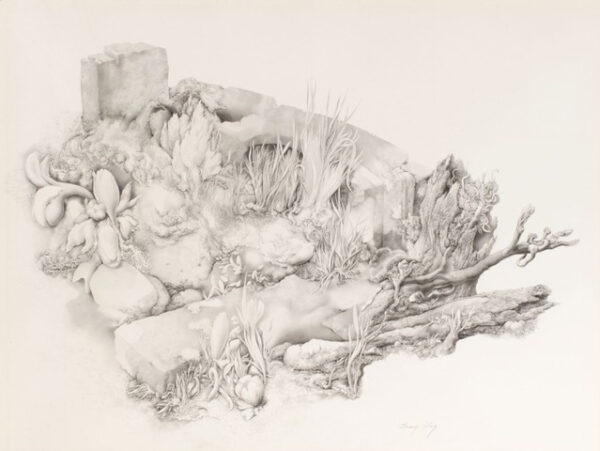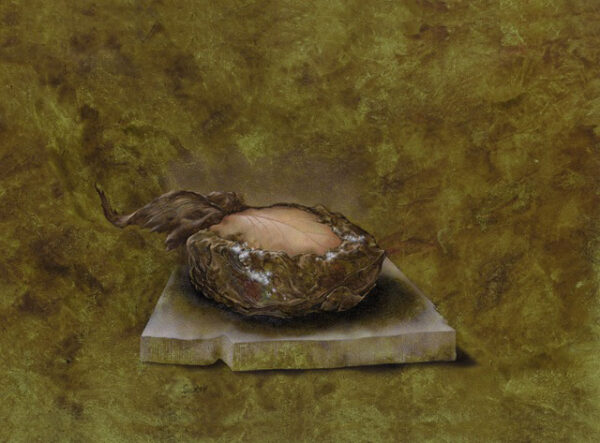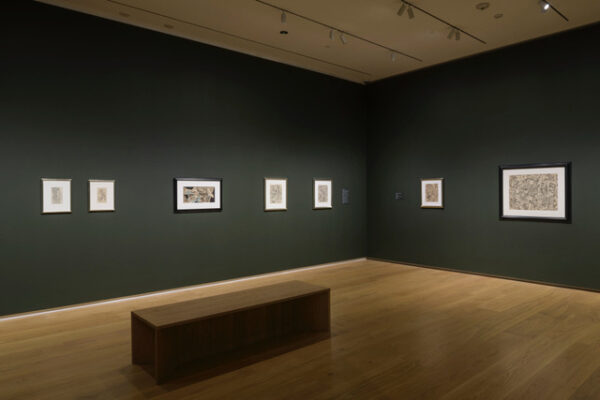Looking closely is the essence of Hyperreal: Gray Foy at the Menil Drawing Institute, an exhibition featuring finely detailed drawings by the artist created from the 1940s to the 1970s. Foy’s drawings range from surreal stagings of humanoid creatures to botanical and geological subjects; they provide the perfect material for sustained looking, and the museum offers magnifying glasses to encourage a closer view of the magnificent details of these fantastical pieces. Viewers step away with a more meaningful and lasting experience if they spend several minutes, or even longer, with one of Foy’s drawings.
The works are arranged in a sequence to highlight Foy’s transition from the hallucinatory staged drawings of humanoid figures in the earlier years of his career to the botanical landscapes and still lifes depicting nature and other objects. This exhibition also includes examples of some of Foy’s commercial work, on view for the first time, such as several illustrated book covers.

Gray Foy, “Untitled [Illuminated Exterior with Morphing Dancers],” ca. 1946, graphite on paper, 13 1/4 × 10 1/2 inches.
The earlier years of Foy’s work are often comprised of pieces depicting humanlike forms staged in perspective-distorting scenes within a surreal, dreamlike world. In Untitled [Illuminated Exterior with Morphing Dancers], two figures embrace each other and dance in the center of the drawing. They’re surrounded by energetic figures and objects, but they appear to almost morph into one, due to the closeness of their bodies in a moment of deep affection. In the lower left corner of the piece, a giant pair of feet distorts perspective to appear as if the viewer is gazing up at a tall figure. Overhead, a string of lights illuminates this exterior dance scene; however, only a few of the bulbs hanging over the dancers are lit, as if the dancers’ love caused the lights to turn on.
To the right of the dancers, a distorted structure with unusual details, such as a couple of trees growing out of human forms, becomes the scene’s backdrop. Foy often worked by beginning with a single point, allowing the drawing to develop from that point. Although a surreal scene of seemingly unrelated motifs, Foy’s meticulous detail makes these magical images feel real. He offers viewers a clear, unobstructed view of his dreamlike worlds, which elevate his signature, hyperreal style. As a young artist witnessing the end of the Second World War, Foy’s surreal images escape reality, but are also certainly influenced by a world dealing with the fallout of large-scale destruction. The dancers in Untitled [Illuminated Exterior with Morphing Dancers] ignore the chaos surrounding them, and this gentle moment is accentuated by the swirling, hallucinatory scenes on their peripheries.

Gray Foy, “Untitled [Architectural Fragment Overgrown with Plants],” ca. 1969, graphite on paper, 12 3/4 × 16 3/4 inches.

Gray Foy, “Untitled [Cluster of Leaves],” ca. 1957, graphite, watercolor, and opaque watercolor on paper, 7 1/4 x 107/8 inches.
Hyperreal: Gray Foy is curated by Kirsten Marples, Curatorial Associate, Menil Drawing Institute. It is on view at the Menil Drawing Institute through September 3, 2023.
Correction August 29, 2023: This article has been updated to accurately reflect how the Menil Collection acquired Foy’s work. The museum acquired his work through two separate recent gifts, not exclusively from his estate.




